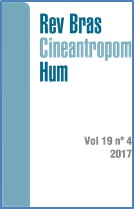Acute neuromuscular response during eccentric overload protocol by using a mechanical device to increase the load
DOI:
https://doi.org/10.1590/1980-0037.2017v19n4p375Abstract
The aim of this study was to propose a mechanical device that could increase the mechanical load during the entire eccentric (ECC) action on a knee flexor machine and to compare the muscular activity when the device was used during a testing protocol. Fifteen physically active women were recruited, and they performed two protocols: control and eccentric overload. Control protocol was performed with concentric (CON) and ECC actions with similar load (60% of one repetition maximum) whilst eccentric overload protocol consisted of ECC actions with 40% more load than CON actions. Muscular activation was measured using surface electromyography of the biceps femoris (BF) and the gastrocnemius medialis (GM) muscles. ECC actions presented a higher muscular activation during eccentric overload protocol than control protocol for BF (p = 0.032), but not for the GM (p = 0.439). The mechanical device increased the mechanical load during the ECC muscle action and consequently increased the amplitude of the neural drive to the BF muscle; however, it did not increase the amplitude of the neural drive to the GM muscle.



